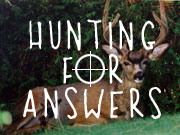Deer season brings in the bucks
November 18, 2002
 |
| Customers at Reed's Sporting Goods store in Walker. (MPR Photo/Tom Robertson) |
Bemidji, Minn. — Mark Wolkerstorfer leans against a sandbag as he prepares to sight in his brand new rifle on a firing range at R&R Arms near Bemidji.
In the weeks before the start of the firearms deer season, R&R Arms is a busy place. As many as 700 hunters will sight their rifles in on the range. Wolkerstorfer took up deer hunting a few years ago. He sees it as a chance to spend time with friends and family.
"I had a father-in-law that was a big hunter. I figured I better start. Otherwise, I'd be the laughingstock of the family," he laughs.
 | |||
Store manager Adam Ballard says about 20 percent of his annual business comes from deer hunters.
"About a month before deer season is probably the single busiest 30 days of the year," says Ballard. "If you were to compare any other month during the year, on average, we probably double our actual sales....For those three weeks of deer hunting, we've got a huge number of people that come up from the Cities, that may come from other states even, to deer hunt in this area."
Close to 500,000 people are participating in this year's deer hunt. They'll spend an estimated $250 million on licenses and supplies. Much of the money is spend in rural Minnesota.
"It's an invasion, of sorts, in these northern towns, and it has been for years," says Jeff Lightfoot, the Department of Natural Resources regional wildlife manager in Grand Rapids.
 | |||
"When you talk to local business people in rural Minnesota -- sporting goods stores, gas stations, cafes -- they depend, in large part, on deer season," says Lightfoot. "The business they get in November -- selling clothes, selling ammunition, selling food, selling gasoline, selling propane -- it's extremely important to small businesses in this part of the state, and all of rural Minnesota."
Deer hunters spend an average of about $500 a year on their sport. But some spend much more. They buy all-terrain vehicles, campers and expensive rifles. Some buy cabins or rural property specifically for deer hunting.
Mark Johnson, director of the Minnesota Deer Hunters Association, says the economic shot in the arm deer hunting provides is huge.
"In every area, every community, come deer hunting, there's a fervor, an excitement, an electricity that permeates through the community," says Johnson. "The businesses are just bustling. Everybody is looking for orange. They're looking for gloves. They're looking for tree stands. They're looking for food. All kinds of things."
 | |||
At Reed's Sporting Goods store in Walker, there are 1,400 guns to choose from on the showroom floor. Owner Jeff Arnold says he sells about 5,000 firearms a year. That's more than any other family-owned sporting goods store in the country. Deer hunting-related sales represent about 40 percent of his multi-million dollar business.
Arnold says he's heard lots of talk about the threat of chronic wasting disease this season. But he says the store is as busy as ever.
"Imagine the month before. Every Saturday, the deer hunters are coming in. We're averaging 3,000 customers a day," says Arnold. "Even at school they talk about it. 'Are you going?' and 'How big was your buck?' 'I got mine.' That is the greatest statement of all time. I might hear that, oh, 500 times a day on opening day. 'My buck's outside, I got mine.' I love it," he says.
The DNR says there were early concerns that fears of chronic wasting disease would curb license sales and lessen the economic impact of deer hunting. But as of the Friday before the season opener, resident license sales were up by nearly 12 percent over last year. DNR officials won't have final license sales numbers until the end of the month.
|
News Headlines
|
Related Subjects
|

